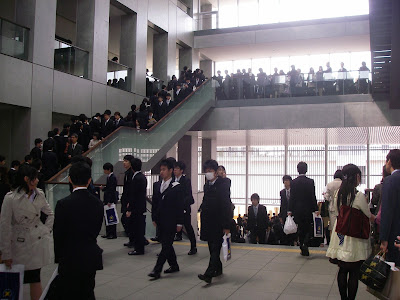In Japanese sunday means a day of sun (like in English). This day of sun was actually the first day in Tokyo so far without sun is´itself. But the e´weather was still very warm and nice.
Today the first time I slept in and woke up at 7 and not at five, probably bacause lack of sleep last night. After taking a bowl of rice and a coffee, I woke Ondrej up and we decided to go for a run in an hour or so.
SUNDAY IN JAPAN
This was our first day of sun in Japan. But there is a big difference with Vienna, where nothing is open on Sunday. A convenience store around the corner is 24-7, so the morning coffee for 150 yen ( 1,2 Euro) I bought there.
Kotani San and his family were up quite early and greeted us with sadomasochism's (good morning). Additionally, the people were still moving in to the dorm, even on Sunday. As I have noticed, parents were helping most of the students to move in. Few of them had some tables and chairs with them, so I guess the rooms of Japanese students will be even more equipped than mine.
Today we took another running route. To be more precise, I rook a running route and Ondrej a roller-blading route, as he is roller-blading while I am running. We went in the direction of Motosumiyoshi metro station. The area is very nice, people are nice and friendly. Some stare at us as if we were Gaijins (foreigners). LOL
We found a great small stream with beautiful sakura on the sides. It took us to a large sports ground with a couple football fields and baseball diamond. There very many Japanese there, many were practicing sports, while elderly people were looking at youngsters competing. THat is a great way to spend Sunday morning. Now I started thinking, that Japanese sports culture is stronger, than I thought.
SHIMODA STUDENTS DORMITORY
Before we went there, Ondrej and I decided to visit another dorm (Shimoda). It is an international students dorm mostly, thus the rules there are not as strict as in our dorm. We entered easily by accompanying a random guy that we met in front of the entrance. Than without knowing, in which rooms our friends were, we easily managed to find it, as each room had a name of the student in front of it. There are 4 floors in the building, each floor has a shared kitchen. We arrived at the place around 7 in the evening, but there was no one eating, quite a quiet place.
Borislav had a little bottle of rice wine and was kind enough to share it with us. Larry, our colleague from Taiwan, has mentioned that in rice wine you have to look at percentage on the label. This percentage indicates how much rice was washed of at the preparation process. The wines with percentage under 50 are of superior quality' have a different name and cost starting from 10000 JPY. We had a little bottle with 70%, quite a new taste for me.
RUNNING SUSHI
This evening we decided to attend a traditional Japanese running sushi restaurant. The place was quite small with a relatively strong fish smell. We all took a seat around a sushi bar. It was a time to do all preparations before the meal. First we had to take a box with powdered green tea and put two scoops in a cup, than added hot water to it. I should call the taste very specific. At the next step we added soya sauce mixed with wasabi to special plate and opened hashi (chopsticks). Now we were finally set and ready.
The sushi were passing by. You would only have to grab a plate of sushi that you liked. Each plate had 2 sushi on it, however the golden plate had one piece of sushi (those were tuna sushi for example). After you are done the staff simply counts your plates and you pay 105 JPY per plate (a little less than 1 Euro). Great experience! I'll come again after I learn all the names of the fish and other ingredients they put on sushi :)
BIKING CULTURE
Japanese have a very strong biking culture. Many people have bikes, however to see a nice mountain bike or professional bike is rare. Japanese people usually do not lock their bikes. Bikes for Japanese are used as a means of transportation from home to closest metro station or to a groceries store. The distances in Tokyo are really long, thus traveling by bike is not really possible. By the way, buying a car is only permitted if you have a confirmed spot on a parking lot.
So everyone has one of those classical bikes looking like this. (Photo). The interesting thing about this, as bicycles are really cheap here, many people leave them unattended, because utilizing them is expensive. So there are many bikes on the streets of Tokyo that belong to no one. Police goes around bikes' parking lots and marks the bikes that have to be removed by their owners (if they are left unattended for long time). If the bike that was marked remains there for a long time and will be removed. As I understand, the bikes can be resold or demolished after. There are few places when it is possible to buy a removed bike. From what I heard, it is possible to get a bike in a great condition for up to 6000 Yen, which is really cheap in Austrian standards, however very expensive by Holland's standards (at least that is what Borislav said).












.jpg)
.jpg)
.jpg)






